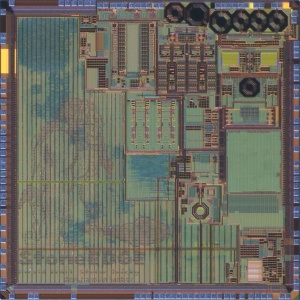Difference between revisions of "Internet of Things SoC Characterization"
From iis-projects
(Created page with "thumb|RF-SoC for the Internet of Things die foto. ==Introduction== By the end of the decade billions so called Internet-of-Things (IoT) devices will be...") |
|||
| Line 1: | Line 1: | ||
| − | [[File:StoneEDGE.jpg|thumb|RF | + | [[File:StoneEDGE.jpg|thumb|Die photograph of the 2G IoT RF SoC called [[stoneEDGE]] revB1.]] |
==Introduction== | ==Introduction== | ||
| − | By the end of the decade billions so called Internet-of-Things (IoT) devices will be connected to the Internet. IoT nodes can range from electrical energy meters to tiny positioning nodes connected to a network. While legacy 2G GSM has long been used for cellular IoT applications, recent advancements in the 3GPP standardization organization address the growing need for IoT modems. In particular, the Extended Coverage GSM for IoT (EC-GSM-IoT) standard with 20 dB coverage increase and low-power features got finalized in 2016 [1]. Current research at the institute led to a prototype of an EC-GSM-IoT modem RF-SoC in autumn 2016. The SoC includes RF circuitry and a digital baseband ASIC for 2G EC-GSM-IoT, GSM, GPRS, EGPRS, and EGPRS2A operations. | + | By the end of the decade billions so called Internet-of-Things (IoT) devices will be connected to the Internet. IoT nodes can range from electrical energy meters to tiny positioning nodes connected to a network. While legacy 2G GSM has long been used for cellular IoT applications, recent advancements in the 3GPP standardization organization address the growing need for IoT modems. In particular, the Extended Coverage GSM for IoT (EC-GSM-IoT) standard with 20 dB coverage increase and low-power features got finalized in 2016 [1]. Current research at the institute led to a prototype of an EC-GSM-IoT modem RF-SoC in autumn 2016 as an revC1 enhancement to the [[stoneEDGE]] project. The SoC includes RF circuitry and a digital baseband ASIC for 2G EC-GSM-IoT, GSM, GPRS, EGPRS, and EGPRS2A single-carrier multislot class 45 operations. During this project, the revD1 stoneEDGE chip will leave fabrication and will be measured as well during this project. |
==Project Description== | ==Project Description== | ||
While some basic measurements have been made with the prototype SoC, extensive measurements include: | While some basic measurements have been made with the prototype SoC, extensive measurements include: | ||
* Power consumption for various operation modes | * Power consumption for various operation modes | ||
| − | * | + | * Block Error Rate (BLER) curves under challenging channel conditions (including strong interferes). |
| − | * RF characterization, e.g. Noise Figure (NF) measurements over various frequency bands | + | * RF characterization, e.g. Noise Figure (NF) measurements over various frequency bands. |
| − | The institute counts with state-of-the-art protocol analyzers, channel emulators, and RF equipment for proper measurements. During this project, the | + | The institute counts with state-of-the-art protocol analyzers, channel emulators, and RF equipment for proper measurements. During this project, the students will setup and perform numerous measurements for proper SoC characterization. |
| − | ===Status: | + | ===Status: In Progress === |
| − | : | + | : Students: Michael Bisig and Julian Keller (gra16h1) |
| − | : Supervision: [[User:Weberbe|Benjamin Weber]] | + | : Supervision: [[User:Weberbe|Benjamin Weber]], [[User:Mkorb|Matthias Korb]] |
| − | |||
| − | |||
| − | |||
| − | |||
| − | |||
| − | |||
| − | : | ||
| − | |||
===Professor=== | ===Professor=== | ||
| Line 28: | Line 20: | ||
==References== | ==References== | ||
| − | [1] | + | [1] 3GPP. Release 13. http://www.3gpp.org/release-13, 2016. |
| + | |||
[[Category:Digital]] | [[Category:Digital]] | ||
| − | [[Category: | + | [[Category:Group Work]] |
| − | [[Category: | + | [[Category:In progress]] |
| − | |||
| − | |||
[[Category:Telecommunications]] | [[Category:Telecommunications]] | ||
[[Category:Weberbe]] | [[Category:Weberbe]] | ||
| + | [[Category:Mkorb]] | ||
Revision as of 18:34, 2 December 2016

Introduction
By the end of the decade billions so called Internet-of-Things (IoT) devices will be connected to the Internet. IoT nodes can range from electrical energy meters to tiny positioning nodes connected to a network. While legacy 2G GSM has long been used for cellular IoT applications, recent advancements in the 3GPP standardization organization address the growing need for IoT modems. In particular, the Extended Coverage GSM for IoT (EC-GSM-IoT) standard with 20 dB coverage increase and low-power features got finalized in 2016 [1]. Current research at the institute led to a prototype of an EC-GSM-IoT modem RF-SoC in autumn 2016 as an revC1 enhancement to the stoneEDGE project. The SoC includes RF circuitry and a digital baseband ASIC for 2G EC-GSM-IoT, GSM, GPRS, EGPRS, and EGPRS2A single-carrier multislot class 45 operations. During this project, the revD1 stoneEDGE chip will leave fabrication and will be measured as well during this project.
Project Description
While some basic measurements have been made with the prototype SoC, extensive measurements include:
- Power consumption for various operation modes
- Block Error Rate (BLER) curves under challenging channel conditions (including strong interferes).
- RF characterization, e.g. Noise Figure (NF) measurements over various frequency bands.
The institute counts with state-of-the-art protocol analyzers, channel emulators, and RF equipment for proper measurements. During this project, the students will setup and perform numerous measurements for proper SoC characterization.
Status: In Progress
- Students: Michael Bisig and Julian Keller (gra16h1)
- Supervision: Benjamin Weber, Matthias Korb
Professor
References
[1] 3GPP. Release 13. http://www.3gpp.org/release-13, 2016.